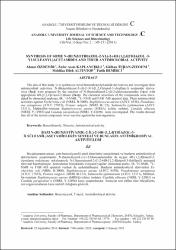Synthesis of Some N-(Benzothiazol-2-YL)-2-(4H-[1,2,4]Triazol -3- Ylsulfanyl)Acetamides and Their Antimicrobial Activity

Göster/
Erişim
info:eu-repo/semantics/openAccessTarih
2011Yazar
Özdemir, AhmetKaplancıklı, Zafer Asım
Turan Zitouni, Gülhan
Altıntop, Mehlika Dilek
Demirci, Fatih
Üst veri
Tüm öğe kaydını gösterÖzet
The aim of this study is to synthesize novel benzothiazolyl-amide derivatives and investigate their antimicrobial activities. N-(Benzothiazol-2-yl)-2-(4H-[1,2,4]triazol-3-ylsulfanyl) acetamide derivatives (3a-j) were prepared by the reaction of N-(benzothiazol-2-yl)-2-chloroacetamides (1a-e) with appropriate 4H-[1,2,4]triazol-2-thione (2a-b). The chemical structures of the compounds were elucidated by elemental analyses, IR, :¹H-NMR, ¹³C-NMR and FAB⁺-MS spectral data. Their antimicrobial activities against Escherichia coli (NRRL B-3008), Staphylococcus aureus (ATCC 6538), Pseudomonas aeruginosa (ATCC 27853), Proteus vulgaris (NRRL B-123), Salmonella typhimurium (ATCC 13311), Methicillin-resistant Staphylococcus aureus (MRSA) (clinic isolate), Candida albicans (NRRL Y-12983) and Candida parapsilosis (NRRL Y-12696) were investigated. The results showed that all of the tested compounds were inactive against the test organisms. Bu çalışmanın amacı, yeni benzotiyazolil-amid türevlerini sentezlemek ve bunların antimikrobiyal aktivitelerini araştırmaktır. N-(benzotiyazol-2-il)-2-kloroasetamidler ile uygun 4H-[1,2,4]triazol-2-tiyonların reaksiyona sokulmasıyla N-(Benzotiyazol-2-il)-2-(4H-[1,2,4]triazol-3-ilsülfanil) asetamid türevleri hazırlanmıştır. Sentezlenen bileşiklerin kimyasal yapıları elemental analiz, IR, ¹H-NMR, ¹³C-NMR ve FAB⁺-MS spektral verileri ile aydınlatılmıştır. Bunların antimikrobiyal aktiviteleri Escherichia coli (NRRL B-3008), Staphylococcus aureus (ATCC 6538), Pseudomonas aeruginosa (ATCC 27853), Proteus vulgaris (NRRL B-123), Salmonella typhimurium (ATCC 13311), Methicil-lin-resistant Staphylococcus aureus (MRSA) (clinic isolate), Candida albicans (NRRL Y-12983) ve Candida parapsilosis’e (NRRL Y-12696) karşı araştırılmıştır. Sonuçlar test edilen tüm bileşiklerin, test organizmalarına karşı inaktif olduğunu gösterdi.
Kaynak
Anadolu Üniversitesi Bilim ve Teknoloji Dergisi C - Yaşam Bilimleri ve TeknolojiBağlantı
https://hdl.handle.net/11421/1710Koleksiyonlar
- Cilt.01 Sayı.2 [8]

















